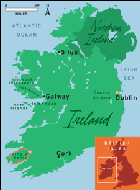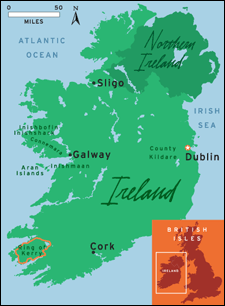“Now we won’t give in to the temptation of a path!” says my Irish guide, Michael Gibbons, as he steps defiantly off the road and plunges up to his ankles into a spongy green bog. An archaeologist by trade and self-described “expert walker and great talker” by disposition, the 45-year-old Gibbons is far more inclined to follow the ruins of a 4,000-year-old wall or a good storyline than he is a decent road or trail.
Traveling Ireland
 LOVELY LONELINESS: A fairy tree near Maam Cross; Michael Gibbons and his walking crew admire cliffs near Inishbofin
LOVELY LONELINESS: A fairy tree near Maam Cross; Michael Gibbons and his walking crew admire cliffs near InishbofinMap of Ireland
 Map of Ireland by Evan Hecox
Map of Ireland by Evan HecoxI obediently follow Michael, bracing for the inevitable squish of cold bog in my already damp boots. This is the third day of our five-day trek, and by this time I’m confident that Michael knows where he’s going. This is his home turf, after all—he’s walked every patch and puddle of this rocky, soggy, wild, and ancient 800 square miles of western Ireland, known as Connemara, a region of County Galway that falls right between the rugged Atlantic coast and Lough Corrib, the country’s second-largest lake.
As the son of immigrants who left Ireland’s County Leitrim, about 80 miles northeast of Connemara, some 50 years ago to make a life in America, I’d followed the recent rise of the “New Ireland” of high-tech office parks, hip clubs, and haute cuisine with mixed feelings. Having inherited (along with a taste for good whiskey) an unabashedly romantic and wistful attachment to “the old country,” I had come with Michael on this 50-mile trek from Ireland’s outer islands to the Connemara mainland with a clear mission in mind: to make sure that my Emerald Isle of donkey carts and whitewashed thatch cottages, of turf fires and the fairy tales told around them, hadn’t entirely disappeared.
Our quest began on the remote isle of Inishmaan, a lonely six-square-mile nub of limestone inhabited by fewer than 200 souls. Tiny Inishmaan is in the center of the Aran Islands, a windswept mini-archipelago that the contemporary poet Seamus Heaney once called “the three stepping stones out of Europe.” A century or so earlier, the Irish poet and playwright J. M. Synge found his own literary inspiration here among the islanders, whose simple life he described as “perhaps the most primitive that is left in Europe.”
At first glance, little appears to have changed on Inishmaan since Synge lived here. Our first day, we set off on a three-mile hike from the island’s ferry pier through An Cora, the main village, and up to the ruins of Dún Fearbhaigh, the 3,000-year-old Iron Age fort that looms over the village. We wind our way up narrow cobbled paths through a maze of mortarless stone walls built and rebuilt by generations of islanders to shield their sheep and potatoes from unrelenting winds. We pass rows of overturned curraghs, boats that Aran fishermen have used for centuries to fish and trap lobsters. These days the lobsters are caught and flown straight to Paris’s finest restaurants.
As we walk, I graze on ripe wild blackberries while attempting to make sense of signs that appear only in Gaelic, the ancient Celtic tongue that remains the lingua franca of Inishmaan and most of Connemara. (One faded pub sign reads is fearrde thú guinness—”Guinness is good for you.”) Back in Synge’s day, says Michael, “English was a language you’d only talk to a pig or a dog in.” Given the way some of the locals eye us as they say hello, I suspect not much has changed.
Back in An Cora, we run into Tarlach de Blacam, a dapper ex-Dubliner in his mid-fifties who runs a shop selling the islands’ famous fine knits. Tarlach came to Inishmaan more than 35 years ago to study Gaelic, fell in love with the place, and decided to stay forever. “Back then it was dark,” he recalls fondly. “No electricity. Just the flickering of fires and candles.” Only toward the end of our conversation do we learn that his shop is just the showroom for a profitable export business, Inis Meáin Knitting Company (Inis Meáin being the Gaelic spelling for the island). “I’m off to New York tomorrow to meet with Saks Fifth Avenue,” he adds casually as he shakes hands and rushes to catch the ferry.
Following a night of drinking and good craic (pronounced “crack” but translated as harmless Irish “fun”) at Teach Ostan Inis Meáin, one of the island’s two pubs, I go about repairing my liver the Irish way: with a binge breakfast of sausages, rashers (bacon), eggs, and black pudding, a congealed pig’s-blood product cleverly disguised as another sausage. Afterwards, a ferry shuttles us back to the mainland—a few pounds heavier than when we arrived.
Three hours later we find ourselves climbing hills and sloshing through peat bogs near Maam Cross, a crossroads ten miles south of the coast. The area was made famous as the setting for the 1952 John Wayne classic The Quiet Man. The skeletal ruins of long-abandoned cottages and remnants of old potato furrows fill the landscape. “Believe it or not,” says Michael, “this was once one of the most densely populated parts of Europe—before the famine hit,” referring to the devastating potato blight that claimed more than half a million lives and sent boatloads of emigrants to America between 1845 and 1850.
These days, points out Michael, it’s mostly cities like Dublin that are booming, thanks to the “Celtic Tiger,” the nickname given to Ireland’s raging economy, which, since the early nineties, has ranked among the fastest-growing in Europe. With the help of expats moving in from the United States and England to fill high-tech jobs at places like Dell, Intel, and Microsoft, Ireland’s population tops four million for the first time since 1872.
As we stumble up a green hillside between Maam Cross and the village of Recess, Michael grabs my shoulder. “Careful, now, of the fairy tree!” I wipe rain from my glasses and scan the dense mist, half expecting to see a Lucky Charms look-alike flitting about. Instead there’s a single wind-pummeled tree sprouting through moss and rocks on an otherwise barren hillside. “Locals will tell you fairies live under trees like that,” says Michael. “They’ll never cut one down, for fear of retribution. In some cases they’ve even diverted highways around them.” In a country that’s hurtling into modernity, I find it comforting to think that the placement of high-speed motorways can still be dictated by concerns of fairy displacement.
After two days of bog-tromping through lashing rain, we drag ourselves, dripping and hungry, into the Lough Inagh Lodge Hotel, a sprawling 125-year-old Tudor-style mansion nestled next to the Twelve Bens and Maamturks Mountains, just 42 miles west of Galway, and surrounded by some of the best fly-fishing streams in all of Europe. The rosy-cheeked lodge owner, showing true Irish hospitality, stuffs our wet boots with newspaper, sets them by the fire, and leads us into an oak-paneled pub decorated with a taxidermy zoo. “Slainte!” he says, offering up the traditional Gaelic toast along with a frothy pint of Guinness and a lunch of native smoked salmon on brown bread and a crabmeat-and-avocado salad.
A van whisks us from lunch westward to the port town of Cleggan, 30 minutes away, where we switch to a ferry and chug 40 minutes over gut-churning swells to arrive on Inishbofin, the “Island of the White Cow.” We head off to catch the sunset over the Atlantic, walking a hillside through what Michael calls a “relic landscape.” Three-thousand-year-old walls—half-submerged in fields of clover—lead to the doorsteps of what he identifies as the remains of ancient homes. “Welcome to your Bronze Age B&B!” he announces as we cross the lichen-covered threshold.
As we leave Connemara the next day and drive the 80 miles back to Shannon Airport, sheep meadows are replaced by Dunnes department stores and a billboard touts Guinness, with its 198 calories, as the hip, low-calorie beer of choice for the young, waistline-conscious Irish.
In my five days in Ireland, I never spotted a single donkey cart, and the only thatch cottages I encountered were on the verge of becoming archaeological. But what I found instead was a thriving, vital Ireland where ancient ways have found modern expression, where fairies are still a force to be reckoned with, and where the Guinness is just as good for you as it ever was.
To bog-tromp and fairy-spot with a true master, contact Michael Gibbons at Walking Ireland, in Clifden, Connemara’s largest town. Michael offers everything from half-day rambles to an epic ten-day circuit of Ireland’s sacred mountains, with prices beginning at $27. You can count on wet boots, spectacular vistas, and good craic. 011-353-95-21492, The best of old and new Ireland can be found under one splendid roof, at the Lough Inagh Lodge Hotel in Recess, where room and board for two begin at $268 per night, depending on the season. 011-353-95-34706,


